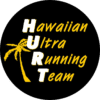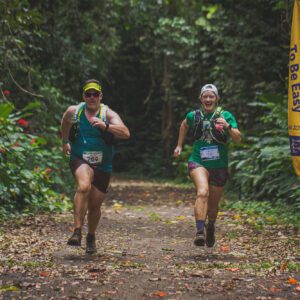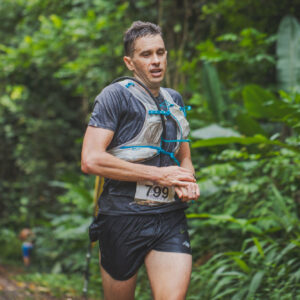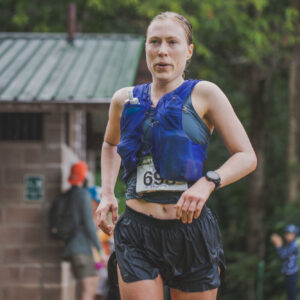Plain 100 Race Report by Larry Inouye
Race Report – Plain 2008
Plain is, as they say, is “Just Plain Tough.” There is no other way to describe it.
The website says “There are 75 miles of trail and 25 miles of forest service roads, all remote. Elevation gain and loss of 21,000 feet. Train for a fairly steep and difficult course with great scenery.”
Beware, only the last statement is true. I’ve heard that the actual course distance is between 106 and 112 miles, depending who you talk to. And a highly reliable source who has attended all of the Plain races indicated that the real elevation gain and loss is estimated to be around 26,000 feet. (One of the runners had an Avocet altimeter and we are trying to contact him to see what was actually recorded.)
The course is a never-ending series of climbs and descent with very few flat areas. Just when you think you have a momentary respite, you start climbing all the way to the top or descending all the way down to the bottom. The climbs and descents seem to go on endlessly; there never seems to a half-assed climb or descent in which you can cruise on level ground midway somewhere on the mountain. It’s all or nothing and there aren’t many “nothings” on this course. The trails vary from clean dirt trails to deep dirt “powder” (from motorcycles) to highly technical sections covered with very sharp edged granite rocks and boulders. Yes, I rolled an ankle, fell down and cut my legs, but that’s about par for me so I’m used to it.
The dust from the pulverized dirt dominates the course. It gets into your shoes, even with gaiters on. Maybe Jamie Gifford had the right idea—he didn’t wear gaiters. On the other hand, he is so fast; the dust doesn’t have an opportunity to get into his shoe or clothes. I bet he was really “clean” when he finished, not like me. I ended up with about three tablespoons of dust in each shoe at the end of the race (this after a sock change at Deep Creek). Not only that, I was coated with the stuff, even in my shorts and under my two shirts. The dust also mixes in with your sweat and Bag Balm and hardens into a pretty tenacious glue. It takes a lot of soap to wash it off. If you run with someone, you either stay tight right behind him or give him about a 75-100 yards lead. Since I was always behind Jeff, I caught the brunt of it and inhaled a lot of it. My mouth was dry and tasted chalky for much of the race. The next day I thought I was dying when I blew my nose and huge blood clots and dust came out. This is went on for two days and I got worried enough to start thinking about going to the ER. However Jeff said that this is a “normal” occurrence at Plain and this lasts about a week. The dust is abrasive, like fine sandpaper and when it gets wet, well, things can get really ugly in a very short period of time. Check out the picture of Jeff’s blistered, macerated foot. I don’t know how he ran with a foot like that. This started well before the Deep Creek “aid” station. I think he ran about 70 miles on that foot.
The trails are marked but can be very confusing as to which trail that you actually take when you come upon the intersections. Race Director Tom Ripley said to “just do what you read and not spend any time “interpreting” the instructions. You do not need the map.” Good advice if you are fresh and lucid, not so good when you are tired and cold and it’s dark. In the beginning, I looked at the instructions a few times and compared it to the trails just to see if I could understand them. They work, but later in the day, I got confused a couple of times. (Case in point – leaving Deep Creek, I continued down the road instead of taking the trail. This cost me about 25 minutes and a lot of panic energy as I ran hard to find Jeff. Many thanks to Jim Kerby for quickly getting me back on track (I look forward to seeing you (well, behind you and Jamie anyways), at HURT 2009.) On several occasions, we saw footprints going off on the wrong trail and we later found out that these were made by a couple of Plain veterans who quickly corrected. Good thing that Jeff was there. He knows the course like the back of his hand and has the important stuff like where to get water down. Or, more importantly, where you won’t get water for 5 hours such as when you start to climb Signal Peak (up 4,500 feet in six miles).
The views are awe-inspiring and you need to remember that you are in the real wilderness. I was somewhat surprised when we checked in at the Thousand Lakes check booth only to see a sign about bears in the vicinity. On the trail, you can see all kinds of tracks and black tuffs of coarse hair which I took to be bear. At one point, I was running ahead of Jeff when I hear a load moaning sound. Jeff yelled for me to turn around and go to him. I asked him “why?” and he said that he heard a bear growling. And he wants me to run TOWARDS him and a bear? I don’t think so.
Signal Peak was an incredibly tough, steep and dusty climb. Jeff mentioned that there is a false summit about two-thirds of the way up and don’t get lulled by it. It is easy to get discouraged by the false summit; the only thing to do is keep moving. Mauricio needed some water at the top so I gave him a nearly full bottle. Steve, Matt, yes, Jeff did his throwing up thing halfway up the mountain. He looked pretty green too. But, I knew he would bounce back and he did. Mauricio and I were at the top talking and next thing you know, here comes the Huffer running full bore right past us. We could not keep up with him. I finally caught him at the bottom, only because he was filling his bottles at the stream.
A word about the water and rivers and streams. They are very, very cold. So cold, that you can feel the ambient air temperature drop by 10-15 degrees even before you get to the water. So cold that it is enough to hurt or numb your hands when you hold your water bottles after filling them. Mauricio had the right idea in that he had bottles insulated with neoprene. I had regular bottles and the cold went right through my lightweight cotton gloves. We didn’t bother with filtering or sterilizing the water. Huff and I figured that if we got sick from the water, well, we would be home by that time. We really didn’t care and Race Director Tom said that no one has ever gotten sick from drinking the water straight up. And, don’t forget, this is the water than Anhauser Bush uses to make their beer. So, it can’t be bad, right?
We ended up at Deep Creek a little late, but in really great shape. Leon Draxler, Becky Gifford, Jim Kerby, and others were there to take care of us. We raided our drop bags and changed our socks. Poor Jeff, he thought he could drain his blisters, however, his feet are so heavily callused, nothing could be done. You got to give him credit, though. No complaints, just wanted a fresh pair of socks, coffee in his bottles, LOTS of Mountain Dew, and steaming hot potato soup. Potato soup? Yep, potato soup, courtesy of Marian Yasuda. (On my last long training run at Peacock Flats, Marian came out to pace me for the second loop. At the end of the run, she brought out a thermos of warm potato soup. Man, that’s the best! Not only does it taste really, really great, it goes down very easy, is loaded with good calories, and simply energizes you. Marian realized how much I enjoyed the soup, as a result she cooked up a batch and froze it for me to take to Plain where Leon made sure it was heated up and ready for us.) The hot soup and terrific homemade energy bars (she spoiled us big time!) were just what we needed to get us going thru the second loop. Thanks, Marian, not only for the goodies, but also for training with me and Jeff and for mentoring me through all of my training.
And, special thanks goes to Leon, who took my grocery list before we arrived and bought all of my food, took Jeff and I in when we flew into Seattle, drove us to Plain, helped us set up our gear before the race, gave us great advice about the course, took really good care of us at Deep Creek, took care of us after the race and drove several miles to get real ice cream milkshakes for us to celebrate, carried our heavy bags to and from the car because we were stiff as the rusty Tin Man, drove us back to Seattle that evening, and generally put up with our every wish. Every single wish, folks, and with a smile. Leon, you are the best! Thank you. You will be notified when we do our next race.
Loop 2 is just as difficult as Loop 1, if not more so because you do a lot of it in the dark and you already have been on the course for 16 hours. Not surprisingly (autumn is only about two weeks away), it was very cold and by early morning there was a nice layer of frost all over the dirt trails and vegetation. I used a HURT short-sleeved shirt covered by a long-sleeved Railrider shirt, all covered by a very lightweight windbreaker which worked fine. I also wore cheap cotton gloves instead of my liner gloves so my hands were on the cold side but it was nothing major. We were fortunate to have such good weather, the last time a HURT team went to Plain, they enjoyed everything from rain, hail, wind and snow.
The climbs are not as long as in the first loop, but they are still very steep and numerous. Chikumin Tie is a key point but its cut off time seems to be off. I have to think this one through but making the cutoff time at Chikumin Tie doesn’t necessarily mean you will make the finish in time, unless you really keep up the effort. You want to get to Chikumin Tie well before the cutoff; otherwise, you will be scrambling to make the finish in time. We got there well ahead of the cutoff time despite both of us throwing up on the climb up. (Steve/Matt, I figure if it worked for Jeff, it would work for me. I did feel better afterwards, as did Jeff. Nothing like leaving some of your innermost bodily fluids and DNA behind.)
It is noteworthy to mention that Jeff had splits for much of the course and we managed to hit most of them dead on, mostly because he was constantly changing our pace to get us there on time. It was kind of fun for me to see how accurate he was. We would be running and I would suddenly ask him something like “How many minutes to the next water stop or SAR or key check point?” Jeff would think a minute or two and give me an answer. Invariably, he was correct or pretty close. I never asked for mileage but always for time since this was harder to do because our pace would change all the time. It was pretty fun for me and I made it even more difficult at times by asking him at somewhat inappropriate times such as when he was working really, really hard on a climb and breathing heavily. I think I asked him that same question about 27 times during the entire race. I kept waiting for him to say “shut the hell up” but he never did.
Once we passed Chikumin Tie, we knew that we would be able to finish the course in time, provided we didn’t get hurt or get lost. We slowed our pace and took extra time to verify the checkpoints. This was fun for me and I got a chance to really check out the views. The scenery is awesome and makes you really appreciate how beautiful our country really is. We both felt pretty good going all the way home; I know that Jeff could have shaved off about 103-127 minutes if he left me behind. But, he hung with me all the way through. Thanks, Huffer, you helped me get through my first full 100 and I learned so much from you, not only for this race, but for everything leading up to it. Including the invaluable “how to regurgitate on the run.”
Plain is tough, pretty unique, small and very intimate, and just plain fun. Race Directors Chris Ralph and Tom Ripley are the nicest people around. I think they come from the same stock as Big John and PJ. They were so helpful and really work hard to put on a great race. I was deeply touched when Tom give me a big hug when I crossed the finish line since he knew I had just completed my first 100. And Chris offered to give me two Plain rocks (thank god I took only one, they are heavy). Having such a small group of entrants fosters a lot of camaraderie and everyone, with the exception of me, looked pretty relaxed. The volunteers and Search and Rescue people are great (although SAR will NOT tell you what trail to go onto if you are not sure; they won’t even stop you if you do take the wrong one). The pre-race dinner was great as was the breakfast before the race. Not only that, but as soon as you cross the finish line, the volunteers make sure that you are comfortable, and ply you with soft drinks, homemade brownies, cookies, meatballs, watermelons, and Ben and Jerry’s ice cream (all you can eat). I hope they don’t change a thing.
Finally, lest I forget, thank you to the HURT family. I know that going to Peacock Flats is a long drive for many of you and we appreciate having you with us during our training out there. Cheryl, thanks for feeding us and being there when we needed you. Don, you are truly inspiring to every one of us and you motivate us to go farther, faster, and not give up. Jim Masterson, sorry you couldn’t be with us, but thanks for giving us the kick start on the training and pressuring me into doing this race. Paul and Bob and Barbi (for reminding Bob) for getting me my Moeben sleeves. And Paul again, for getting me larger bottles as I changed my mind at the very last minute. Marian, thanks for running Jeff and I ragged as we tried to keep up with you on many of our training runs; you are forgiven since you ALWAYS fed us some great food! Thanks, too, HURT, for tracking us and your kind, inspirational words on the HURT blog. We had a lot of fun reading them up at Plain and it was very nice to know that you all would be with us every step of the way. You make it a lot easier for us to succeed. Thank you, everyone.



